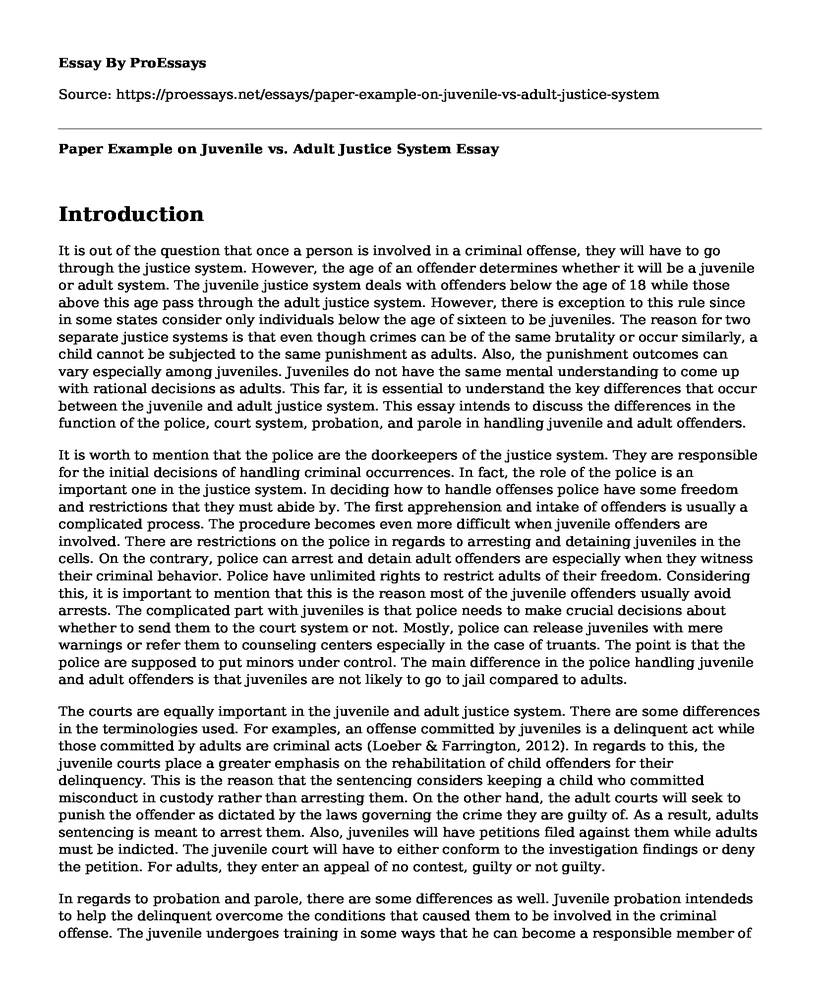Introduction
It is out of the question that once a person is involved in a criminal offense, they will have to go through the justice system. However, the age of an offender determines whether it will be a juvenile or adult system. The juvenile justice system deals with offenders below the age of 18 while those above this age pass through the adult justice system. However, there is exception to this rule since in some states consider only individuals below the age of sixteen to be juveniles. The reason for two separate justice systems is that even though crimes can be of the same brutality or occur similarly, a child cannot be subjected to the same punishment as adults. Also, the punishment outcomes can vary especially among juveniles. Juveniles do not have the same mental understanding to come up with rational decisions as adults. This far, it is essential to understand the key differences that occur between the juvenile and adult justice system. This essay intends to discuss the differences in the function of the police, court system, probation, and parole in handling juvenile and adult offenders.
It is worth to mention that the police are the doorkeepers of the justice system. They are responsible for the initial decisions of handling criminal occurrences. In fact, the role of the police is an important one in the justice system. In deciding how to handle offenses police have some freedom and restrictions that they must abide by. The first apprehension and intake of offenders is usually a complicated process. The procedure becomes even more difficult when juvenile offenders are involved. There are restrictions on the police in regards to arresting and detaining juveniles in the cells. On the contrary, police can arrest and detain adult offenders are especially when they witness their criminal behavior. Police have unlimited rights to restrict adults of their freedom. Considering this, it is important to mention that this is the reason most of the juvenile offenders usually avoid arrests. The complicated part with juveniles is that police needs to make crucial decisions about whether to send them to the court system or not. Mostly, police can release juveniles with mere warnings or refer them to counseling centers especially in the case of truants. The point is that the police are supposed to put minors under control. The main difference in the police handling juvenile and adult offenders is that juveniles are not likely to go to jail compared to adults.
The courts are equally important in the juvenile and adult justice system. There are some differences in the terminologies used. For examples, an offense committed by juveniles is a delinquent act while those committed by adults are criminal acts (Loeber & Farrington, 2012). In regards to this, the juvenile courts place a greater emphasis on the rehabilitation of child offenders for their delinquency. This is the reason that the sentencing considers keeping a child who committed misconduct in custody rather than arresting them. On the other hand, the adult courts will seek to punish the offender as dictated by the laws governing the crime they are guilty of. As a result, adults sentencing is meant to arrest them. Also, juveniles will have petitions filed against them while adults must be indicted. The juvenile court will have to either conform to the investigation findings or deny the petition. For adults, they enter an appeal of no contest, guilty or not guilty.
In regards to probation and parole, there are some differences as well. Juvenile probation intendeds to help the delinquent overcome the conditions that caused them to be involved in the criminal offense. The juvenile undergoes training in some ways that he can become a responsible member of the society. In several occasions, this usually involves correctional counseling and behavioral skill. In the case of adult probation, a criminal is held liable for their acts will trying to bring change in them. In several occasions, they are required to obtain jobs. The offender undergoes training on skill the will make them diverge from crime (Leanne, 2016). For parole, a juvenile gets reintegrated into the community while for adults, they are placed under watch, and their behavior monitored. In case of recurrence of crime, adult offenders will go back to jail.
Conclusion
Given the above differences, there are options in the adult system that can benefit the juvenile system and vice versa. For example, some juveniles commit crimes that far surpasses those committed by adults in regards to brutality. In such a situation the police should handle such a criminal as an adult since they pose a danger to the society. The courts should also consider sentencing juveniles in regards to the nature of the crime they have committed. Some juveniles should be arrested rather than put into custody. On the other hand, the adult system can benefit from the options of using a lot of counseling in integrating offenders back into the society. Also, the choice of having to petition can be useful in adult courts.
References
Leanne, F. A. (2016). Community Based Corrections. Cengage Learning.
Loeber, R., & Farrington, D. P. (2012). From juvenile delinquency to adult crime: Criminal careers, justice policy and prevention. Oxford University Press.
Cite this page
Paper Example on Juvenile vs. Adult Justice System. (2022, May 09). Retrieved from https://proessays.net/essays/paper-example-on-juvenile-vs-adult-justice-system
If you are the original author of this essay and no longer wish to have it published on the ProEssays website, please click below to request its removal:
- Big Intelligence
- Article Review Example on Biological Criminal Behavior
- Research Paper on African American Delinquency
- Essay Sample on Marijuana Use: Debating Mental Health Benefits vs. Risks
- Imprisonment: Ancient Times to Modern Day - Essay Sample
- Essay Example on Obama Care in Texas: Potential Issues and Challenges
- Employee Rights: Fighting Chance for Fair Bargaining - Essay Sample







